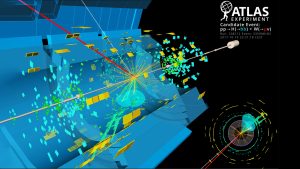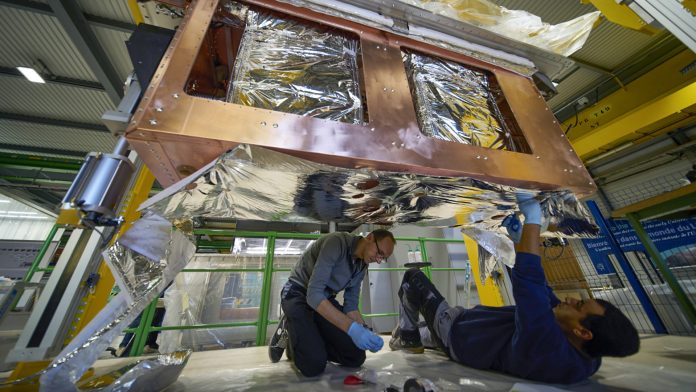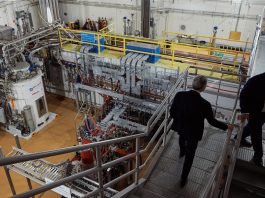Canadian particle accelerator TRIUMF outlines Canada’s contribution to the crucial upgrades of CERN’s Large Hadron Collider and the potential for these advancements to usher in a new era of particle physics research.
Within the many narratives of modern science, certain discoveries have emerged, like thunderclaps, reshaping our understanding of the universe with seismic force. In the realm of contemporary physics, no such discovery has reverberated louder than the first experimental proof of the Higgs boson, a subatomic particle of legendary stature.
The Large Hadron Collider and the Higgs boson
The Higgs boson, predicted more than half a century ago by theoretical physicists including Peter Higgs and François Englert, is widely considered the linchpin of the Standard Model of particle physics. Its existence validates a fundamental concept of our world: The mechanism by which particles acquire mass.
The Higgs boson is akin to a cosmic glue, imbuing all matter with mass and allowing this matter to aggregate, enabling particles to form atoms, compounds, and beyond. Without the Higgs boson, in an alternate universe where particles did not join together in the immediate aftermath of the Big Bang, stars would not form, planets would not coalesce, and life as we know it could not exist.
Our first glimpse of the Higgs was provided in 2012 by the Large Hadron Collider (LHC), a colossal, underground, ring-shaped complex of particle accelerators and detectors that spans the French-Swiss border. The LHC was built at least in part to hunt for Higgs bosons, which had never before been produced in a controlled environment.
The LHC was completed in 2008 and began accelerating protons to near-unfathomable velocities – just 11 kilometres-per-hour shy of the speed of light – and coordinating approximately one billion head-on collisions per second within the two primary detector facilities, ATLAS and CMS.

which produced a Higgs boson. The short-lived Higgs then decayed into a pair of bottom quarks, which are
denoted with blue cones (Credit: ATLAS Collaboration)
Then, after approximately two years of colliding and smashing protons and sifting through the various products and reaction phenomena, researchers announced in 2012 that they had produced experimental evidence that finally proved the existence of the Higgs boson – our first glimpse of the long-postulated and mysterious particle, and the closure of a chapter on one of the most enduring stories in physics.
The creation and recording of the first Higgs boson was the culmination of decades of work to design and build the LHC and resulted in a Nobel Prize in Physics for Englert and Higgs ‘for the theoretical discovery of a mechanism that contributes to our understanding of the origin of mass of subatomic particles, and which recently was confirmed through the discovery of the predicted fundamental particle, by the ATLAS and CMS experiments at CERN’s Large Hadron Collider.’
Though we can now reliably produce Higgs bosons, much work remains to produce them copiously, which will enable us to better study them and learn more about the nature of matter, mass, and how our universe came to exist. Our primary limitation remains that we simply do not have enough Higgs particles!
Even though the LHC can induce one billion collisions per second, including hundreds of millions of collisions useful for study, events which create Higgs bosons are exceedingly rare. Further, researchers must also contend with the fact that the Higgs boson itself decays almost imperceptibly fast, providing only fleeting glimpses of its mechanisms of action.

To produce more Higgs bosons, researchers need more particle collisions – a metric called ‘luminosity,’ which reflects the number of particle collisions per time (and area!) within a particle accelerator.
To do this, researchers are now upgrading the facilities used to produce and record the first Higgs particle – a comprehensive, multi-year upgrade project to recondition the accelerator as the High-Luminosity Large Hadron Collider (HL-LHC). The high luminosity upgrades aim to significantly enhance the collider’s performance, increasing its luminosity by a factor of approximately ten – and massively increasing the supply of Higgs bosons produced for us to study.
Critical Canadian contributions to global physics and accelerator research
For Canada, the HL-LHC upgrades are an opportunity to continue building on the nation’s pivotal role in the development of the LHC, fortify significant historical contributions to the ATLAS detector (one of the two primary detector apparatuses that helped visualise the Higgs boson), as well as continue advancing accelerator research through the development of new accelerator components.
Canadian contributions – led by a community that includes particle physics researchers, engineers, technicians and technical experts, students, and many others – span from cutting-edge detector technology to crucial infrastructure developments, ensuring the success and enhanced capabilities of this next-generation particle accelerator.
Silicon detectors
Many of the key Canadian contributions are funded nationally via the Canadian Foundation for Innovation (CFI) and the Natural Sciences and Engineering Research Council of Canada (NSERC) and are pursued from or enabled by TRIUMF, Canada’s particle accelerator centre. From there, TRIUMF convenes the efforts of a broad network of universities across the country and production facilities across North America. For instance, TRIUMF has played an integral role in the design and development of advanced silicon detectors, which are essential for tracking particles with high precision (and in high-radiation environments), and without which, researchers cannot delve deeper into the fundamental components of matter.
Canadian teams will build approximately 1500 of the 7,000 silicon strip modules required for this part of the detector via two production sites (in western Canada with TRIUMF, Simon Fraser University (SFU) and the University of British Columbia (UBC); and in eastern Canada with the Toronto, Carleton, Montreal, and York Universities).
Dr Isabel Trigger, ATLAS Senior Research Scientist, TRIUMF, said: “TRIUMF is the key to Canada’s participation in the LHC and the HL-LHC, providing the expertise needed to design and build the in-kind contributions to the accelerator that allow the country to join this international project, and the facilities and experts required to build several different detector subsystems.”
Critical upgrades
Working with TRIUMF and a national network of university partners, the ATLAS group has been leading a number of other critical upgrades for the Hi-Lumi era,including: Liquid Argon Calorimeters Electronics Upgrade at the Universities of Victoria, Toronto, and McGill (which will increase signal granularity provided to the L1 trigger); an upgrade for the New Small Wheel that will enable continued triggering on muons with a low momentum threshold; and a variety of other mission-critical upgrades and updates to account for the higher-radiation environment associated with higher luminosity.
In total, these improvements will contribute to the improved resolution and accuracy needed for the HL-LHC’s upgraded experiments.
Cryomodules
Through TRIUMF, the Canadian community is also building five new components called crab cavity cryogenic modules. These sophisticated cryomodules house and cool critically required radiofrequency crab cavities, named for their essential function in the HL-LHC to rotate bunches of particles before they collide, vastly increasing the chance of collision and thus luminosity.
Canada is a world-leader in the cryomodule technology that will surround and cool the cavities to their requisite temperatures and will leverage both TRIUMF’s unique network of expertise and the capacity of the Canadian partner network to design, fabricate, and deliver the crucial upgrade components.
Speaking about the cryomodule upgrades when they were first announced in 2018, CERN Director, Fabiola Giannotti, said: “We are very pleased with Canada’s contribution to the HL-LHC project, which is another important milestone in a long-standing, fruitful collaboration with CERN. The technology and expertise of TRIUMF and Canadian industries, working with the strong particle physics community in the country, will be crucial for the realisation of very ambitious accelerator components for the next major project at CERN.”
Improved computing infrastructure
The HL-LHC will generate vast amounts of data, and managing this data efficiently will make for a critical challenge.
Through TRIUMF, Canada has been contributing significantly to the computing infrastructure required to handle this data deluge. Canadian researchers and institutions, including TRIUMF, the University of Victoria, the University of Toronto, Simon Fraser University (SFU), and the University of Alberta, have been instrumental in developing sophisticated data storage and analysis solutions.
These include hardware contributions, such as high-performance computing clusters, and the development of advanced software algorithms for data processing. Canadian expertise in distributed computing and grid technology has been pivotal in the effort to ensure that the vast quantities of data produced by the HL-LHC can be stored, accessed, and analysed efficiently by researchers around the globe.
To that end, TRIUMF staffs and operates a Tier-1 data centre, a critical repository and computing centre for hosting and processing data funnelled directly from the LHC to SFU, as well as for enabling simulations and physics analyses.
Theoretical studies
In addition to technological and infrastructural contributions, Canadian scientists have been deeply involved in the theoretical and phenomenological studies that underpin the HL-LHC’s research objectives. Researchers from institutions such as the Perimeter Institute for Theoretical Physics contribute to the development of new models and theories.
These theoretical frameworks are essential for interpreting the results from the HL-LHC experiments and guiding future research directions. Canadian theoretical physicists help to ensure that the experimental results are effectively integrated into the broader understanding of particle physics, providing insights that may lead to new discoveries.
Collaboration is crucial
Critically, Canada’s involvement in the HL-LHC project also extends beyond technical contributions to include significant roles in collaboration and leadership. Canadian scientists, including TRIUMF researchers, hold leadership positions within the ATLAS collaboration, influencing the strategic direction of the wider research programme.
This involvement ensures that Canadian perspectives and expertise are well-represented in the decision-making processes that shape the HL-LHC’s scientific agenda and future pursuits. Through these diverse contributions, Canada plays a crucial role in the HL-LHC project, driving advancements in particle physics and expanding our understanding of the universe.
From pioneering detector technology and superconducting magnets to leading-edge data management and theoretical research, TRIUMF and other Canadian institutions and scientists are key players in ensuring the success and impact of the HL-LHC.
This multifaceted involvement not only highlights Canada’s scientific and technological capabilities but also reinforces its position as a significant contributor to global scientific endeavours.
More broadly, the HL-LHC project is a globally coordinated effort involving significant contributions from various international partners. For instance, American institutions are developing advanced superconducting quadrupole magnets using niobium-tin (Nb3Sn) technology, crucial for focusing proton beams.
Several European countries, through CERN and individual national programmes, are providing expertise in detector technology, superconducting materials, and cryogenic systems. Nations like Italy, Germany, France, and others are heavily involved in improving the collimation systems to protect the collider from stray particles and updating software and related systems.
These international collaborations ensure the HL-LHC’s technological advancements and operational success, propelling the field of particle physics forward by enabling more precise measurements and the discovery of rare phenomena.
The future of LHC in Higgs boson research
Beyond its role as the linchpin of the Standard Model and the particle that enables the Universe, the Higgs boson beckons us to push the boundaries of human inquiry. Through experimentation with Higgs particles, we can delve deeper into the quantum realm, where new research avenues and beyond-Standard Model physics may yet lie in wait.
For many researchers and innovation partners, the discovery of the Higgs boson was not merely a milestone – it has become a catalyst for potential within the realm of high-energy physics.
Many hope it will also serve as a beacon, illuminating the path towards a more profound understanding of the cosmos, our place within it, and how we can continue to push the boundaries of science for the betterment of society.
While the exact nature of Higgs boson research (including what we will learn as we continue to study it and how these learnings will benefit science and society) to be seen, researchers from TRIUMF and across the global physics community stand ready to guide us into this exciting and unprecedented era of high-luminosity science at the LHC.
Please note, this article will also appear in the 19th edition of our quarterly publication.





